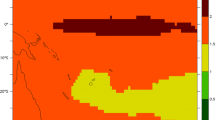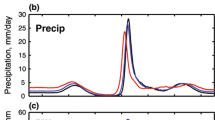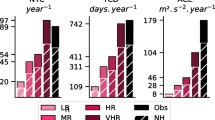Abstract
Fine-resolution regional climate simulations of tropical cyclones (TCs) are performed over the eastern Australian region. The horizontal resolution (30 km) is fine enough that a good climatological simulation of observed tropical cyclone formation is obtained using the observed tropical cyclone lower wind speed threshold (17 m s–1). This simulation is performed without the insertion of artificial vortices (“bogussing”). The simulated occurrence of cyclones, measured in numbers of days of cyclone activity, is slightly greater than observed. While the model-simulated distribution of central pressures resembles that observed, simulated wind speeds are generally rather lower, due to weaker than observed pressure gradients close to the centres of the simulated storms. Simulations of the effect of climate change are performed. Under enhanced greenhouse conditions, simulated numbers of TCs do not change very much compared with those simulated for the current climate, nor do regions of occurrence. There is a 56% increase in the number of simulated storms with maximum winds greater than 30 m s–1 (alternatively, a 26% increase in the number of storms with central pressures less than 970 hPa). In addition, there is an increase in the number of intense storms simulated south of 30°S. This increase in simulated maximum storm intensity is consistent with previous studies of the impact of climate change on tropical cyclone wind speeds.













Similar content being viewed by others
References
Arakawa A (1972) Design of the UCLA general circulation model. Numerical simulation of weather and climate. Techn Rep 7, Department of Meteorology, University of California, Los Angeles, USA
Basher RE, Zheng X (1995) Tropical cyclones in the southwest Pacific: spatial patterns and relationships to Southern Oscillation and sea surface temperature. J Clim 8: 1249–1260
Bengtsson LM, Botzet M, Esch M (1995) Hurricane-type vortices in a general circulation model. Tellus 47A: 175–196
Bengtsson L, Botzet M, Esch M (1996) Will greenhouse gas induced warming over the next 50 years lead to higher frequency and greater intensity of hurricanes? Tellus 48A: 57–73
Bengtsson L, Botzet M, Esch M (1997) Numerical simulation of intense tropical storms. In: Diaz HF, Pulwarty RS (eds) Hurricanes: climate and socioeconomic impacts. Springer, Berlin Heidelberg, New York, pp 67–92
Bureau of Meteorology (1998) Tropical cyclone warning directive. Available from Bureau of Meteorology, Queensland Regional Office, GPO Box 413, BRISBANE QLD 4001, Australia
Davies HC (1976) A lateral boundary formulation for multi-level prediction models. Q J R Meteorol Soc 102: 405–418
DeMaria M (1996) The effect of vertical wind shear on tropical cyclone intensity change. J Atmos Sci 53: 2076–2087
Emanuel KA (1988) The maximum intensity of hurricanes. J Atm Sci 45: 1143–1155
Fiorino M (2002) Analysis and forecasts of tropical cyclones in the ECMWF 40-year reanalysis (ERA-40). Proc 25th Conf Hurricanes and Tropical Meteorology, San Diego, 29th April–3rd May, 2002, American Meteorological Society, pp 261–264
Gallina GM, Velden CS (2002) Environmental wind shear and tropical cyclone intensity change using enhanced satellite derived wind information. Proc 25th Conf Hurricanes and Tropical Meteorology, San Diego, 29th April–3rd May, 2002, American Meteorological Society, pp 172–173
Geleyn JF (1987) Use of a modified Richardson number for parameterizing the effect of shallow convection. In: Matsuno T (ed) Short- and medium-range numerical weather prediction. Spec Vol J Meteorol Soc Japan, pp 141–149
Giorgi F, Brodeur CS, Bates GT (1994) Regional climate change scenarios over the United States produced with a nested regional climate model. J Clim 7: 375–399
Giorgi F, Hewitson B, Christensen J, Hulme M, von Storch H, Whetton P, Jones R, Mearns L, Fu C (2001) Regional climate change information – evaluation and projections. In: Houghton JT, Ding Y, Griggs DJ, Noguer M, van der Linden PJ, Dai X, Maskell K, Johnson CA (eds) Climate change 2001 – the scientific basis. Intergovermental Panel on Climate Change, Cambridge University Press, Cambridge, UK, pp 583–638
Gordon C, Cooper C, Senior CA, Banks H, Gregory JM, Johns TC, Mitchell JFB, Wood RA (2000) The simulation of SST, sea ice extents and ocean heat transports in a version of the Hadley Centre coupled model without flux adjustments. Clim Dyn 16: 147–168
Gordon HB, O’Farrell SP (1997) Transient climate change in the CSIRO coupled model with dynamic sea ice. Mon Weather Rev 125: 875–907
Gordon HB, Rotstayn LD, McGregor JL, Dix MR, Kowalczyk EA, O’Farrell SP, Waterman LJ, Hirst AC, Wilson SG, Watterson IG, and Elliott TI (2002) The CSIRO Mk 3 Climate Systems Model, CSIRO Atmospheric Research Techn Pap 60
Hastings PA (1990) Southern Oscillation influences on tropical cyclone activity in the Australian/south-west Pacific region. Int J Climatol 10: 291–298
Hart R (2002) A cyclone phase space diagram derived from thermal wind and thermal asymmetry. Proc 25th Conf Hurricanes and Tropical Meteorology, San Diego, 29th April–3rd May, 2002, American Meteorological Society, pp 45–46
Hirst AC (1999) The Southern Ocean response to global warming in the CSIRO coupled ocean–atmosphere model. Environ Model Software 14: 227–241
Holland GJ (1997) The maximum potential intensity of tropical cyclones. J Atmos Sci 54: 2519–2541
IPCC (2001) Climate change 2001 – the scientific basis. Cambridge University Press, Cambridge, UK 881 pp
Kattenberg A, Giorgi F, Grassl H, Meehl GA, Mitchell JFB, Stouffer RJ, Tokioka T, Weaver AJ, Wigley TML (1996) Climate models: projections of future climate. In: Houghton JT, Meria Filho LG, Callander BA, Harris N, Kattenberg A, Maskell K (eds) Climate change 1995: the science of climate change, Cambridge University Press, Cambridge, UK, pp 285–357
Knutson TR, Tuleya RE (1999) Increased hurricane intensities with CO2-induced warming as simulated using the GFDL hurricane prediction system. Clim Dyn 15: 503–519
Knutson TR, Tuleya RE, Kurihara Y (1998) Simulated increase of hurricane intensities in a CO2-warmed world. Science 279: 1018–1020
Knutson TR, Tuleya RE, Shen W, Ginis I (2001) Impact of CO2-induced warming on hurricane intensities as simulated in a hurricane model with ocean coupling. J Clim 14: 2458–2468
Krishnamurti TN, Correa-Torres R, Latif M, Daughenbaugh G (1998) The impact of current and possibly future sea surface temperature anomalies on the frequency of Atlantic hurricanes. Tellus 50A: 186–210
McGregor JL, Walsh KJ, Katzfey JJ (1993) Nested climate modelling. In: Jakeman AJ, Beck MB, McAleer MJ (eds) Modelling change in environmental systems. Wiley, Chichester, UK, pp 367–386
Nguyen K-C, Walsh KJE (2001) Interannual, decadal and transient greenhouse simulations of tropical cyclone-like vortices in a regional climate model of the South Pacific. J Clim 14: 3043–3054
Pielke RA Jr, Landsea CW (1998) Normalized Atlantic hurricane damage 1925–1995. Weather Forecast 13: 621–631
Royer J-F, Chauvin F, Timbal B, Araspin P, Grimal D (1998) A GCM study of the impact of greenhouse gas increase on the frequency of occurrence of tropical cyclones. Clim Change 38: 307–343
Shapiro LJ (1987) Month-to-month variability of Atlantic tropical circulation and its relationship to tropical cyclone formation. Mon Weather Rev 115: 2598–2614
Sugi M, Noda A, Sato N (2002) Influence of the global warming on tropical cyclone climatology: An experiment with the JMA global model. J Meteorol Soc Jpn 80: 249–272
Tonkin H, Landsea C, Holland GJ, Li S (1997) Tropical cyclones and climate change: a preliminary assessment. In: Howe W, Henderson-Sellers A (eds) Assessing climate change: results from the Model Evaluation Consortium for Climate Assessment. Gordon and Breach, Australia, pp 327–360
Tsutsui J-I (2002) Implications of anthropogenic climate change for tropical cyclone activity: a case study with the NCAR CCM2. J Meteorol Soc Jpn 80: 45–65
Tsutsui J-I, Kasahara A (1996) Simulated tropical cyclones using the National Center for Atmospheric Research community climate model. J Geophys Res 101: 15,013–15,032
Walsh KJE, Katzfey JJ (2000) The impact of climate change on the poleward movement of tropical cyclone-like vortices in a regional climate model. J Clim 13: 1116–1132
Walsh KJE, Ryan BF (2000) Tropical cyclone intensity increase near Australia as a result of climate change. J Clim 13: 3029–3036
Walsh KJ, Watterson IG (1997) Tropical cyclone-like vortices in a limited area model: comparison with observed climatology. J Clim 10: 2240–2259
Yoshimura J, Sugi M, Noda A (1999) Influence of greenhouse warming on tropical cyclone frequency simulated by a high-resolution AGCM. Proc 23rd Conf Hurricanes and tropical meteorology, 10–15 January 1999, Dallas, American Meteorological Society, pp 1081–1084
Acknowledgements.
The authors would like to thank the State Government of Queensland, particularly the Department of Natural Resources and Mines, and CSIRO for supporting this work. Jack Katzfey, Mike Fiorino and an anonymous reviewer made comments that improved the work.
Author information
Authors and Affiliations
Corresponding author
Rights and permissions
About this article
Cite this article
Walsh, K.J.E., Nguyen, KC. & McGregor, J.L. Fine-resolution regional climate model simulations of the impact of climate change on tropical cyclones near Australia. Climate Dynamics 22, 47–56 (2004). https://doi.org/10.1007/s00382-003-0362-0
Received:
Accepted:
Published:
Issue Date:
DOI: https://doi.org/10.1007/s00382-003-0362-0




